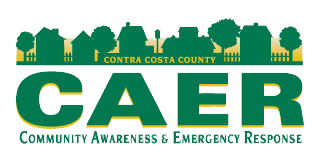2020 CAER Highlights
A message from Tony Semenza, executive director of Contra Costa CAER.
First, I would like to wish everyone a very Happy New Year filled with much happiness and good health. As we all are aware due to the pandemic 2020 was a very difficult year for everyone but CAER continued to work toward its goals.
CAER is a non-profit public benefit corporation dedicated to community awareness and emergency response. Contra Costa CAER continues to be one of the largest and most active CAER groups in the country with membership including representatives from industry, agencies and communities. In 2021 I will be working with our industry partners to try to increase better participation on many of our Action Teams. We will continue to support funding to the Action Teams so that they can accomplish their goals.
The Emergency Preparedness Action Team and the Community Outreach Action Team have joined together to form one Team. This Action Team promotes planning for all types of emergencies by providing a grant program for emergency drills and in 2020 over $10,000 was issued in grants to eight applicants with seventeen applications being received.. Those receiving grants are required to provide CAER with a detailed description on how the funds were used so that we can continue to insure the success of this program. This Team also promotes shelter-in-place education in the community and publicizes the many resources provided by CAER. An example of this is the CAER sponsored annual Countywide Shelter-in-Place drill conducted from 2000-2019 which was offered to all public and private schools. In 2020 due to the pandemic we were unable to conduct this drill in person. However, we did do a live presentation via Zoom. We are planning to have a Shelter-in-Place drill on Wednesday November 3, 2021 at 11am.
The Petrochemical Mutual Aid Action Team continues to work with local fire departments on conducting training and coordinating drills so that in the event of an emergency either at a fixed facility or in the community these groups can work together to mitigate the incident. They discuss ER/Safety incidents and near misses, evaluate emergency response equipment and supplies, provide emergency response mutual aid, study and implement best practices and review incidents and share lessons learned.
The Security Action Team works with law enforcement, regulatory agencies and industry to share security related information/alerts/occurrences. They provide a forum to share best practices, facilitate and improve interface among law enforcement, regulatory agencies and industry and discuss and develop methods to educate security response personnel.
The Industrial Hygiene Action Team discusses new regulations and standards related to industrial hygiene to promote effective implementation and standardization as appropriate. They share best practices, provide industrial hygiene mutual aid to the PMAO Action Team during incidents using mutual aid and assist in improvements in air monitoring efforts.
The Process Safety Action Team reviews process safety incidents/near misses and shares lessons learned. They discuss new regulations and standards and provide a forum for sharing risk management and loss prevention principles.
The Haz Mat Action Team’s purpose is to minimize the risk and impact of hazardous materials emergencies by integrating regional response training within the 16 counties of the CA OES Region II. They include training needs for EMS, law enforcement, fire, haz mat response teams, personnel, industry employees, and other resources. This team continues to work with its members on planning workshops in the future that will benefit OES Region II.
The Emergency Notification Action Team’s mission is to improve emergency notification including the Community Warning System and other mechanisms used to make timely and consistent notifications to community and agencies during an industrial accident. This team identifies problems associated with emergency notification and establishes/recommends policy for hazardous material incidents. The Community Warning System is operating on an internet based platform which allows communications to be very timely. We continue pursuing ways to upgrade the system using the best available technology.
For the past 20 years CAER has facilitated a Safety Summit Program. To date we have had 66, the last one being held in December of 2019. Due to the ongoing COVID 19 restrictions and in consultation with the Contra Costa County Health Services, CAER cancelled all of its planned 2020 Safety Summits because the safety and well-being of our participants is of the utmost importance. This program brings together subject matter experts from industry, agencies and communities to share lessons learned, near misses and best practices. In 2021 we are we are planning to conduct two Safety Summits, one in September and one in December. We continue to work with Martinez Refining Company and Contra Costa County Health Services to make these happen.
All of our Action Teams were not able to meet in person but did continue to do business by conducting their meetings via Zoom or teleconference calls. CAER’s Board of Directors which is comprised of a cross section of community, industry and agency representatives who are committed to providing the support that is crucial for the continued success of our Action Teams and committees was also able to conduct business via Zoom.
Wally visits First Baptist Head Start program in Pittsburg
Wally visits them every year to review Shelter in Place procedures. Taken on October 2015.
Click on an image below to open in gallery view
Martinez 4th of July Parade and Celebration






Wally and friends make an appearance at the annual Main Street Martinez Fourth of July Parade
and Celebration.
A Very Successful Shelter-in-Place Drill Held at Marchus School
by Jonathan Lance, Contra Costa County Office of Education
 CONCORD, Calif., November 7, 2013—On November 6, it was a very pleasant and quiet autumn Wednesday morning at Contra Costa County Office of Education’s Marchus School, in Concord, when all of sudden, the County Warning System siren went off! Immediately following, a campus PA system directed all students and personnel into their classrooms and offices, and to close the doors behind them. The Marchus School was participating with nearly 200 other Contra Costa County schools and day-care centers in the 12th Annual Countywide Shelter-in-Place Drill to practice safety procedures in the event of a nearby hazardous material release or other incident requiring them to shelter-in-place.
CONCORD, Calif., November 7, 2013—On November 6, it was a very pleasant and quiet autumn Wednesday morning at Contra Costa County Office of Education’s Marchus School, in Concord, when all of sudden, the County Warning System siren went off! Immediately following, a campus PA system directed all students and personnel into their classrooms and offices, and to close the doors behind them. The Marchus School was participating with nearly 200 other Contra Costa County schools and day-care centers in the 12th Annual Countywide Shelter-in-Place Drill to practice safety procedures in the event of a nearby hazardous material release or other incident requiring them to shelter-in-place.
This countywide drill is directed by the Contra Costa County Community Awareness and Emergency Response (CAER). CAER’s Executive Director, Tony Semenza, who was on the Marchus campus during the drill, said, “Each year we are encouraged with the increased number of participating schools CAER works with. CAER will continue to work with all the schools and childcare centers in our county to be sure that they know how and when to shelter-in-place. Teachers and students should all know shelter-in-place procedures just as they are trained about what to do in case of a fire or earthquake. I encourage everyone to join us in preparing for the worst so that we may do our best during an emergency.”
This annual safety event gives children and their caregivers an important opportunity to practice responding to the Community Warning System (CWS) alerts, which includes a series of sirens along the waterfront from Richmond to Antioch. The CWS sounds a siren when there has been a dangerous chemical release or other disaster that requires a shelter-in-place. These alerts are also sent via radio, TV, and Social Media postings.
Hazardous material releases can result from many sources in Contra Costa County, including accidents at chemical treatment plants, wastewater treatment facilities, facilities that store and/or manufacture hazardous materials, refineries, but also from collisions involving trucks or trains that transport chemicals. The possibility of accidents, make it important for the county’s youngest members to recognize and respond correctly to shelter-in-place alerts.
 Long-time Marchus School teacher and campus emergency coordinator Jack Grossman (pictured on right) said, “The kids are always so cooperative when we hold our drills.” No argument from the members of CAER who were on hand to monitor the drill. As soon as school Administrative Assistant Michelle Kiernan gave the announcement over the PA, doors began closing up tight, and the few students and staff that were outside quickly followed into their classroom. At the same time, the school’s HVAC system went immediately into shutdown (so no dangerous air would pump into the campus buildings). During the ten-minute shelter-in-place drill, the CAER people were able to check the entire campus to make sure all specific emergency measures were taken. After everything was checked, it was then back to business.
Long-time Marchus School teacher and campus emergency coordinator Jack Grossman (pictured on right) said, “The kids are always so cooperative when we hold our drills.” No argument from the members of CAER who were on hand to monitor the drill. As soon as school Administrative Assistant Michelle Kiernan gave the announcement over the PA, doors began closing up tight, and the few students and staff that were outside quickly followed into their classroom. At the same time, the school’s HVAC system went immediately into shutdown (so no dangerous air would pump into the campus buildings). During the ten-minute shelter-in-place drill, the CAER people were able to check the entire campus to make sure all specific emergency measures were taken. After everything was checked, it was then back to business.
Semenza (pictured on left) also reported, “This was a very successful drill, and I am so impressed with the different emergency plans that Grossman has generated for all types of emergencies this school could encounter: fire, bomb threat, earthquake, chemical spill or air quality, and intruder. Jack has each emergency readied with a campus-wide warning signal and specific procedures.” Grossman says that the school practices one of these drills a month.
Thanks to Grossman, Marchus School was able to secure an emergency grant from CAER earlier this year. He used the money to purchase portable toilets, emergency supplies, and canopy tents. “We are equipped to safely stay on campus for three days, if needed,” says Grossman.
It was a very impressive drill, and quite notable how Grossman and other Marchus employees work so hard to keep their students and fellow employees safe.





